 |
|||
 |
||||
CALENDAR |
||||||||||||||
HOME |
||||||||||||||
Mercury
Clean Air Act (CAA) industrial mercury emissions control: creation of mercury hot spots? Can Hg emission credits be traded like those for gaseous emissions (carbon dioxide)?
Recent research of relationship between autism risk and industrial mercury hot spots raises questions about affect of trading emission credits on creations of Hg hot spots .
The joint EPA-FDA Advisory on mercury and fish consumption: what it says and does not; what it means and does not. Clearing up the confusion [see . Guidelines, fact sheets and frequently asked questions [see Toxicology & the Home].
New research on low level neurotoxic effects of mercury: scientific evidence on both sides of the controversy [see Toxicology of Science].
EPA responds to petitions from States, Environmental Groups and Indian tribes to reconsider changes to the CAA that would allow cap trading of mercury releases. Review events leading up to recent development. Public comments invited (deadline for comments was December 17, 2005).

Exposure Assessment
What does this mean? It means that the reference dose provides a reliable, scientific guideline as to the risk of adverse effects from mercury intoxication under a variety of exposure scenarios in a number of difference population groups. Identifying one’s population group and exposure scenario and appropriately applying these risk assessment guidelines and principles to the findings, will identify one’s risk. How that information is then used is a judgement call.
There is no controversy that cigarette smoking increases the risk of lung cancer, as well as other health problems, because smokers compared to non smokers get lung cancer at an increased ten fold rate, a striking increase in risk. But who gets lung cancer cannot be predicted—there are clearly unknown or unknowable factors that ultimately determine this final outcome in an otherwise clear-cut increase in risk. And in fact, nine out of ten—90 percent, the vast majority—of smokers will not get lung cancer. Whether one focuses on the increased risk compared to non smokers or the unlikelihood of being the one-in-ten who will get lung cancer, is an individual judgement call beyond the ability of science or risk assessment.
2. Regulatory Guidance
The Food and Drug Administration (FDA) sets ‘action levels’ for food, which are designed to maintain a certain purity to the food, in terms of all types of contaminants, from toxic chemicals to fecal count to animal parts. For mercury the limit is set at 1 ppm, which translates to 1 ug/g of fish, including tuna. The Environmental Protection Agency established a reference dose (RfD) of 0.1 ug/kg bw/day (one microgram per kilo gram body weight per day). EPA established a consumption level based on body size, rather than the concentration in food, which does not directly reflect consumption levels or body size. However, both are based on assumptions and data of average consumption levels and body weight size.
More perplexing is the March 2004 Joint Advisory by FDA and EPA, as to how much people and pregnant women could eat safely. This advisory does not square with the EPA RfD of 0.1 ug/kg bw/day. For example, it advises that pregnant women or a young child can eat 12 ounces of Chunk Light Tuna or one six ounce can of Albacore White Tuna. Albacore contains on average 0.353 ppm of mercury, or 0.353 ug/g tuna. A six ounce can, or 170 grams, would contain, 0.353 ug/g X 170 g = 60 ug. A 44 pound child would weigh 20 kg, so according to the RfD the threshold would be 0.1 ug/kg bw/day = 0.1 ug/kg X 20 kg/day, or 2ug X 7 days, or 14 ug/week. The Advisory allows that child’s consumption of tuna to exceed by a factor of more than four times the RfD. It also prohibits consumption of four fish—Shark, Swordfish, King Mackerel or Tilefish (Gulf of Mexico)—because of ‘high mercury levels,’ but high mercury levels is not just a function of concentration but amount consumed, which is not considered. King Mackerel, for example, contains a concentration of mercury of 0.730, twice the concentration in Albacore Tuna. But if specifically 6 ounces of Albacore Tuna is allowed, why not 3 ounces of King Mackerel? These questions leave much room for interpretation on either side of the debate, creating confusion rather than clarifying it. (See also EPA explanation of Advisory).
3. Risk/benefit of Tuna (fish)/mercury consumption
The consideration of Tuna consumption and mercury exposure involves both a risk assessment and a benefit analysis. The risk assessment requires a full understanding (not that difficult) of the concentrations of mercury in Chunk Light Tuna versus Albacore, versus other fish; the level of consumption (average or well above average); and the susceptibility group (fetus, child, pregnant woman, etc.) Part of that is addressed in #2, above; the remainder is addressed in #4, below. It is worth looking at the comparison of fish mercury levels to get an idea of where Tuna fits in and what the alternatives are. Then one can also consider the benefits of each fish to see what else would meet the need with lowered risk, if that is a concern.



